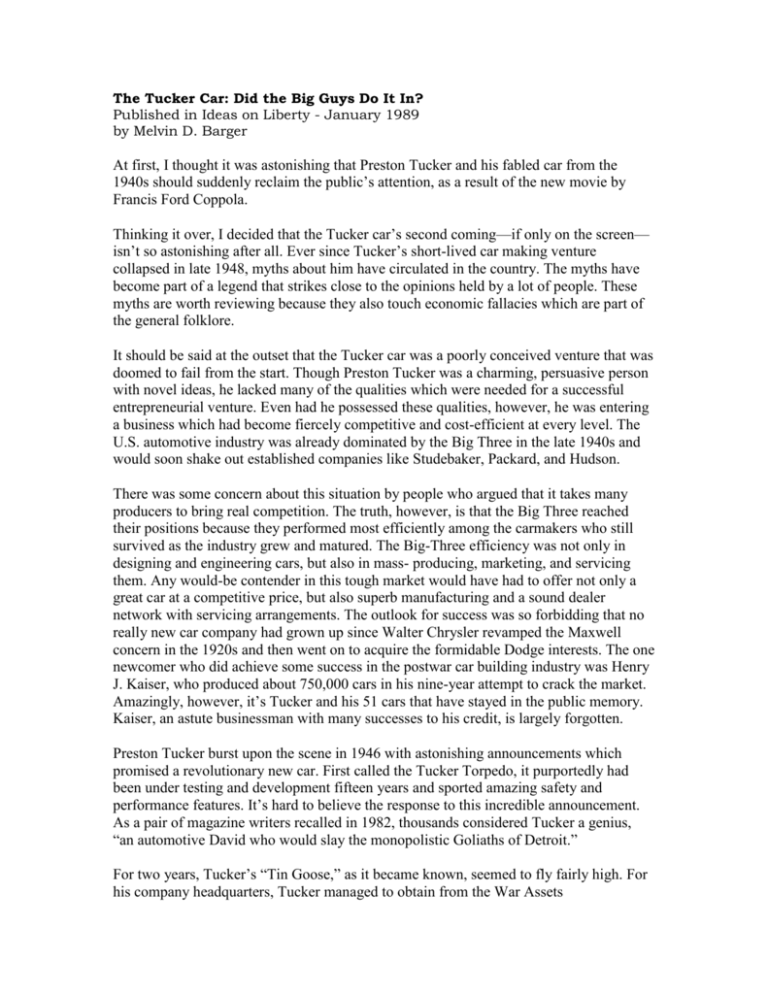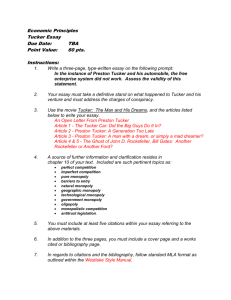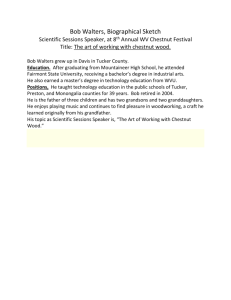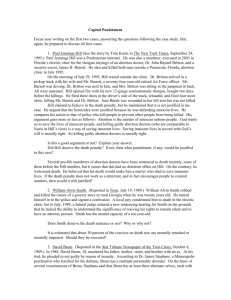The Tucker Car: Conspiracy or Business Failure?
advertisement

The Tucker Car: Did the Big Guys Do It In? Published in Ideas on Liberty - January 1989 by Melvin D. Barger At first, I thought it was astonishing that Preston Tucker and his fabled car from the 1940s should suddenly reclaim the public’s attention, as a result of the new movie by Francis Ford Coppola. Thinking it over, I decided that the Tucker car’s second coming—if only on the screen— isn’t so astonishing after all. Ever since Tucker’s short-lived car making venture collapsed in late 1948, myths about him have circulated in the country. The myths have become part of a legend that strikes close to the opinions held by a lot of people. These myths are worth reviewing because they also touch economic fallacies which are part of the general folklore. It should be said at the outset that the Tucker car was a poorly conceived venture that was doomed to fail from the start. Though Preston Tucker was a charming, persuasive person with novel ideas, he lacked many of the qualities which were needed for a successful entrepreneurial venture. Even had he possessed these qualities, however, he was entering a business which had become fiercely competitive and cost-efficient at every level. The U.S. automotive industry was already dominated by the Big Three in the late 1940s and would soon shake out established companies like Studebaker, Packard, and Hudson. There was some concern about this situation by people who argued that it takes many producers to bring real competition. The truth, however, is that the Big Three reached their positions because they performed most efficiently among the carmakers who still survived as the industry grew and matured. The Big-Three efficiency was not only in designing and engineering cars, but also in mass- producing, marketing, and servicing them. Any would-be contender in this tough market would have had to offer not only a great car at a competitive price, but also superb manufacturing and a sound dealer network with servicing arrangements. The outlook for success was so forbidding that no really new car company had grown up since Walter Chrysler revamped the Maxwell concern in the 1920s and then went on to acquire the formidable Dodge interests. The one newcomer who did achieve some success in the postwar car building industry was Henry J. Kaiser, who produced about 750,000 cars in his nine-year attempt to crack the market. Amazingly, however, it’s Tucker and his 51 cars that have stayed in the public memory. Kaiser, an astute businessman with many successes to his credit, is largely forgotten. Preston Tucker burst upon the scene in 1946 with astonishing announcements which promised a revolutionary new car. First called the Tucker Torpedo, it purportedly had been under testing and development fifteen years and sported amazing safety and performance features. It’s hard to believe the response to this incredible announcement. As a pair of magazine writers recalled in 1982, thousands considered Tucker a genius, “an automotive David who would slay the monopolistic Goliaths of Detroit.” For two years, Tucker’s “Tin Goose,” as it became known, seemed to fly fairly high. For his company headquarters, Tucker managed to obtain from the War Assets Administration a huge Chicago plant which Dodge had operated during World War II. Early success in selling stock and dealerships eventually brought in about $26 million. Though the responsive public became restive over Tucker’s failure to produce a car, he finally displayed one in a highly dramatized showing on July 19, 1947. Now called the Tucker “48,” the display model captivated crowds with its aerodynamic design, rearmounted engine, and such supposedly advanced safety features as a Cyclops center headlight which turned with the wheels and a windshield to pop out in an accident. Though the display model also drew record crowds when Tucker took it on tour, it turned out that the vehicle had been hastily put together and actually had no reverse gear at the original showing. The suspension system had failed and had been frantically rebuilt just before the show. Some of the body had been fabricated around a 1942 Oldsmobile body. The more serious problem was that Tucker apparently had no sound plan or even blueprints for getting the car into real production. The 51 Tucker cars actually produced were hand-built models fabricated at enormous cost. One example of Tucker’s profligate ways was revealed in his procurement of transmissions. Tucker obtained salvaged transmissions from the defunct Cord automobile, and then paid a shop owned by his family $223,105 to rework 25 of them. With such weird practices, it’s not surprising that by late 1948 the firm was all but bankrupt. By early 1949 it was all over, with less than $70,000 remaining of the nearly $26 million raised by Tucker from trusting shareholders and would-be dealers. A number of publications, particularly Collier’s magazine, reported on the failure, leaving little doubt that the Tucker venture had been a business seduction of massive proportions. Tucker himself was exonerated of fraud charges, and it’s possible that he had, indeed, fully intended to build and market his dream car. He was reportedly still determined to launch another auto making venture when he died of cancer in 1956 at age 53. Long before Tucker’s death, the myths were already circulating in Detroit. I’m sure I heard them from fellow workers when I worked on assembly in a Detroit engine plant in 1951 and 1952. We heard that Tucker had had such a phenomenal car that the Big Three automakers moved to block it. One of their alleged tactics was to bully their own suppliers into refusing to sell parts to Tucker. They also enlisted the government’s help; and the Securities and Exchange Commission helped speed the Tucker car’s demise by leaking information about the company. Another “villain”—as the new movie makes clear—was Homer Ferguson, a U.S. Senator from Michigan who had strong personal ties to the Big Three establishment. As a student of free-market economics, I’m quick to concede that a government-backed business conspiracy can work to stifle a new venture. The involvement of Senator Ferguson and the SEC does muddy the waters in reviewing the Tucker collapse. In fact, however, Tucker needed no help in destroying his company. The government, if anything, bent the rules in Tucker’s favor when it awarded him the plant in Chicago on very generous terms. As for Senator Ferguson, his more probable concern was not that Tucker would succeed, but that .he was headed for a massive failure which would wipe out shareholders’ investments. The SEC did not doom Tucker, nor did it really carry out its role of protecting investors. Did the Big Three Shut Out Tucker? What about the role of the Big Three auto-makers? Their supposed opposition to Tucker is inferred as a result of a common fallacy about big business concerns. There is a widely held belief that any large business or several “oligopolists” can easily shut out an upstart competitor, either with predatory pricing or some other tactic. The way this story goes, the dominant business simply applies such pressures when a new company appears, and then goes back to its usual exploitative practices after the would-be contender expires. This is a fallacious argument that is often used to explain failure. It can be easily disproved by tracking the number of times newcomers have dislodged established firms. It still survives, however, and it contributed to the Tucker myth. I find it hard to believe that any top manager of a Big Three company actually gave more than a few minutes’ thought to the Tucker venture, let alone conspired to destroy him. While Detroit’s auto executives would have been curious about any new car, they would have been quick to see that the Tucker program was likely to unravel by itself. They were also in the midst of an extraordinary sellers’ market in the late 1940s and had little apprehension that a new competitor might sweep the industry. Nor was there need to fear that failure to bring out a glitzy new body design would cause loss of market share. Though some of them may have admired Tucker’s body design, all of them had new aerodynamic models in progress and planned for early introduction. Studebaker and Hudson, in fact, did beat the Big Three to the market with aerodynamic designs, and yet this did not help them survive in the long run. Even if Tucker had offered a truly revolutionary car, it’s doubtful that Detroit’s managers would have panicked about possible “losses of billions” in the future, as the Coppola movie suggests. The Big Three automakers already knew how to design “dream” cars, as both GM and Chrysler did just before World War II. Their concern was not the design of such cars, but the cost constraints of getting them into production. Again, there is far more required for automotive success than just having a great car. Any top executive of GM or Ford, in looking over the Tucker car, would have immediately questioned whether it could be put into production to support the low sales price Tucker had promised. There would have been questions about its likelihood of giving trouble-free performance and whether the car really delivered the excellent gas mileage promised. And it would have raised some eyebrows if it had been known that Tucker had sneaked reworked Cord transmissions into the car rather than designing his own. There is also scant reason to believe, as some do, that the Detroit automakers bullied their suppliers into refusing to sell parts to Tucker. I had personal knowledge of this as a result of being associated with Libbey-Owens-Ford for 14 years. I learned that Libbey-OwensFord had fabricated Tucker’s pop-out windshield at a time when LOF supplied 100 percent of General Motors’ automotive glass. Had Tucker gone into production, LOF would have continued as his supplier, just as it also supplied glass to other auto and truck manufacturers. (Ford Motor Company had its own glass plants.) Moreover, sales managers are adamant in denying that any carmaker would prevent a supplier from selling to other companies. Rather than making suppliers totally dependent on them, carmakers are more interested in having vendors who are soundly financed and are likely to have a number of customers in order to survive the times when auto production is cut back. It is possible, of course, that in 1948 some suppliers would have been more attentive to Big Three customers than to Tucker. The persistent fear at supplier firms is that a customer may not be able to pay the bills. In view of disturbing rumors that were already circulating about Tucker Corporation in early 1948, any prospective suppliers would have been skittish about selling to the company except on a c.o.d, basis. Tucker, however, never reached the point of ordering production parts in volume. He was never strongly in the market for the parts that supposedly had been denied to him., The most likely Big Three response to Tucker is that the top auto managers noted his company and quickly dismissed it as a speculative venture that would not survive. The duty of following Tucker and reporting on his progress would have been assigned to the market-research person who tracked competitors’ activities. Far from conspiring to destroy Tucker, the Big Three executives were more concerned about competing with each other for the long ton. Another reason given for the Tucker failure is that the SEC leaked damaging information which had the effect of stifling sales of Tucker stock and dealerships. As a result, Tucker fell far short of raising the total amount that would have been needed to get into production. While nobody knows an exact figure for this, $100 million is probably a fair estimate. This was four times the amount Tucker actually raised. The Market Responds Whatever the effect SEC leaks might have had on Tucker’s venture, his failure to raise more capital can be easily explained by the ordinary behavior of the investment market. The surprising thing is not that Tucker failed to finance his venture. What’s really surprising is that he found investors and dealers who were gullible enough to risk $26 million with him. With or without the SEC, the stock market has an intelligence of its own and puts values on shares after they have been sold. Though Tucker was able to milk thousands of small, trusting investors, he was not likely to tap into shrewder ones who realized how speculative his entire venture had become. Price is the stock market’s way of expressing opinion about company values, and in Tucker’s case the share prices plummeted as facts began to surface, virtually foreclosing any hope of raising funds with new equity offerings. Another myth is that Tucker did have a revolutionary car which foretold Detroit’s future. Newspaper articles recently extolled some of the unusual features of the Tucker car: a pop-out windshield, a rear engine, a Cyclops light in the center which turned with the front wheels, a padded dash, and an aerodynamic body style. But were these really the way Detroit went in the future? No carmaker adopted the pop-out windshield, for example, and the Libbey-Owens-Ford engineers who supplied it to Tucker thought it was a bad idea. Few carmakers have adopted a rear engine; and the front-wheel drive has helped eliminate the long drive train. The Cyclops light is a gimmicky idea that intrigues onlookers, but apparently hasn’t been considered an automotive selling point. Credit Tucker with the padded dash and the leap into aerodynamic design, but neither was beyond Detroit’s capabilities. A final feature of the Tucker myth was the David vs. Goliath aspect, always a subject for popular appeal. At the end of the Coppola movie, for example, Tucker is deploring the fact that there’s no place for the little guy in the automotive business. This is in line with the frequently expressed idea that nobody can get rich anymore. We heard that in 1948, just as we occasionally hear it 40 years later. Anybody can disprove it, however, by getting the latest copy of the Forbes 400 wealthiest people and noting how many current multimillionaires were penniless or had not even been born back in 1948. There have been numerous opportunities which were spotted by people like Ross Perot, Sam Walton, or Steven Jobs. Tucker’s point was that the little guy could no longer enter the carmaking business. My point is the same, with the added proviso that car-making is so competitive and risky, and the capital requirements are so high, that it also excludes “big guys.” If there are to be new entrepreneurial ventures in carmaking, they will logically be carried out by wellfinanced companies who already have expertise in heavy manufacturing. You might think, for example, that a firm like Deere.& Company would use its experience as a tractor builder to move into passenger cars. Such companies avoid car manufacturing as they would the plague, knowing that it would mean almost certain losses. The automotive manufacturing business does, however, offer countless opportunities for people in related lines. If car building itself is a “big guy” business, the industry continues to provide excellent opportunities for hundreds of supplier firms. There have also been entrepreneurial firms who came up with new automotive tools and ideas. Add to that the companies which specialize in modifying and rebuilding stock cars for select markets. Tucker himself, if he had possessed more self-understanding and business savvy, might have prospered as a custom car remodeler. He did have a love of cars and he had experience in the automotive field. In a way, the Tucker car itself was a customized remodeling of existing car concepts. Tucker’s use of the Cord trans-mission, for example, showed that he understood nifty innovations which somehow hadn’t succeeded in the market. But one of Tucker’s problems was in being carried away by a “dream” while ignoring the practical work needed to apply it for useful purposes. Mere possession of a dream does not excuse a person from exercising prudence in business relationships. Though Tucker himself escaped conviction on fraud charges, it is fraudulent at this late date to blame his failures on the Big Three automakers. There are lots of sins we can lay at the door of GM, Ford, and Chrysler managements. They have sometimes been arrogant and complacent; they have occasionally misjudged their markets; they have been sluggish in coping with the new worldwide competition. Their faults are typical of big companies: poor communications, slow response to change, and even bad habits growing out of too much success. Most of the time, however, market realities tend to correct such problems. And in criticizing the Big Three, we should never forget that they are the companies that were most influential in putting the nation and even the world on wheels. Let us also be careful not to add Tucker’s failure to any catalog of Big Three wrongs. There’s simply no evidence that any Big Three company was more than an innocent bystander while the Tucker venture was running its erratic course. Tucker did himself in and lost money for lots of trusting shareholders and prospective dealers at the same time. And Tucker was never a victim of anybody or anything other than his own ineptitude. The Tucker Torpedo was a dud from the start, and Tucker was the triggerman with faulty aim. Plot Summary Based on a true story. Shortly after World War II, Preston Tucker is a grandiose schemer with a new dream, to produce the best cars ever made. With the assistance of Abe Karatz and some impressive salesmanship on his own part, he obtains funding and begins to build his factory. The whole movie also has many parallels with director Coppola's own efforts to build a new movie studio of his own. Historical Background In the late 1940's, Preston Tucker intended to mass-produce a "car of the future" with advanced safety, styling, and engineering features. His goal was to create a car that could be powerful, goodlooking and also safe at the same time. Of course, the big car makers at Detroit didn't think much about something new and unknown and therefore, conflict was unavoidable. The Tucker car never went into actual production because a federal investigation into the company's management practices led to its collapse. The automobile has its engine in the rear, an area where the front passenger can crouch during a collision, and a center headlight that turned with the steering wheel. The sedan's most striking feature is its avant-garde styling, developed by Alex Tremulis and J. Gordon Lippincott and Company. Its features— including pop-up tail lights and irregularly shaped windows— give it a futuristic appearance even today. Keep in mind the manufacturing year, 1948. Questions: 1. Preston Tucker has a vision, but what other qualities does he have that make him an entrepreneur? (3) 2. What turned Tucker’s first “no” into a yes that got the vision started towards reality? 3. a) How does Tucker set up the government reps at lunch? b) What is his main selling point during this presentation? 4. What is the difference between “people who write letters” and “people who buy stock?” 5. How does Tucker motivate and encourage the people who work for him? Give an example. 6. Why did Tucker need a Board of Directors? 7. The real Tucker car had many new innovations. What did the innovation of the seat belt imply to a car buying public at that time? 8. Tucker says, “People believe what they read in the papers even if they don’t believe it.” a) What does he mean by this? b) How does this apply to Tucker and his dream? 9. Preston Tucker extols the virtues of the free enterprise system. a) According to him, what is the key to this system? b) What caused Tucker’s downfall given that this system was operating for him? 10. What does Tucker mean when he says, “It’s the idea that counts, Abe, and the dream.” 11 Preston Tucker was known to have a winning personality. One man bet one hundred dollars that "no one could spend five minutes with Preston Tucker and not like him." How did Tucker's magnetic personality contribute to his career and his company? 12. Was Preston Tucker an innovative genius or just a dreamer who did not succeed Preston Tucker A man with a dream, or simply a mad dreamer? Fri Oct 25 2002 By Malcolm Gunn IT'S human nature to cheer for the underdog. In the 100-plus years of automotive history, there have been plenty of underdogs to urge on from the sidelines as they struggled against all odds to achieve success. These are the wideeyed dreamers who have tried - and mostly failed - to carve their image of the future in steel, glass and rubber. Most of us are familiar with some of the great automotive flops of all time. There's John Delorean and his hinged-door (some would say unhinged), stainless-steel wonder that became more famous as a prop in the Back to the Future movie series than anything else. It all ended in bankruptcy for Delorean and the car that wore his name. Before that, there was Malcolm Bricklin and his similarly styled plastic sports car that resembled a do-it-yourself body kit draped over a VW Beetle carcass. It was actually more sophisticated than that, but with a shape that homely, nobody cared to find out more and the Bricklin quickly became a memory. But for the grand-daddy of all failures, nominations begin, and end, with Preston Tucker. Tucker, who was born near Detroit in 1901, spent most of his working life as a salesman in the automobile business. By 1931 he had worked his way up to regional manager for the PierceArrow car company. But the tall, smooth-talking Tucker wanted more. With his good friend Harry Miller, one of the greatest race-car designers of the day, he attempted to take over the Marmon Motor Car Co. The plan went nowhere. In 1935, Tucker talked Edsel Ford, another close acquaintance, into bankrolling 10 Millerdesigned race cars for the Indy 500. Eight were eventually produced, but none managed to finish that year's race. The end of the Second World War found Tucker with a machine shop in Ypsilanti, Mich., and an idea hatched earlier with the now-deceased Harry Miller to produce a car for all those returning servicemen who would be itching to get behind the wheel. Not only would the yet-to-be-produced passenger sedan be exceedingly fast, it would also incorporate a number of advanced safety features that would be the envy of every other automaker. These included a padded dash, heavily reinforced front end, four-wheel independent suspension and a pop-out windscreen constructed of safety glass. But perhaps the most unusual safety item on the Tucker was to be its cyclops-like headlight mounted directly in the middle of the hood - that swivelled right or left in concert with the direction of the front wheels. Noted Duesenberg-Cord designer Alex Tremulis was hired to sculpt the body for Tucker's futuristic car. Using his wartime experience as an aircraft designer, he penned a shape with a remarkable 0.30 drag coefficient - excellent, even by today's standards. At the heart of the Tucker was its 5.5-litre, rear-mounted, horizontally opposed six-cylinder that produced 166 gross horsepower. Originally an air-cooled helicopter engine, Tucker converted it to liquid cooling for use in his car. Transmission choices consisted of a four-speed manual or a four-speed semi-automatic. The Tucker Corp. set up shop in an unused plant in Chicago. Financing came from the sale of 2,000 dealer franchises, as well as a $20 million stock offering. In July 1948, Tucker tested the first eight cars at Indianapolis Motor Speedway with astonishing results. Each was driven for 8,000 high-speed kilometres (5,000 miles) at speeds up to 180 km-h (115 mph) without a problem. But, for Tucker, the real problems began just as production began to roll. Egged on by powerful, Detroit-backed political interests, the Securities and Exchange Commission began investigating Tucker and his somewhat shaky financial structure. The stock offering failed, dealers were suing to recover their money and supplier credit evaporated. By March 1949, after a production run of only 51 cars, the Tucker Corp. was bankrupt and Preston Tucker himself was removed as head of the company. Tucker, along with his associates, was charged with fraud. But following a four-month-long trial, all were acquitted. By then, it was January 1950 and Tucker's dream of building his revolutionary rear-engine wonder had been completely and utterly extinguished. In the mid-1950s, Tucker made one last stab at developing a car using Brazilian financing. But the chain-smoking entrepreneur was stricken with lung cancer. Preston Tucker died at his Ypsilanti home on Dec. 26, 1956. While he was unable to put his revolutionary car in the driveways of American families, Tucker was able to see his dream in the flesh, even if only for a brief time. It's a fate that has often awaited the automotive dreamers of the world. Malcolm Gunn is Wheelbase Communications' chief road tester and historical writer. Wheelbase is a worldwide supplier of automobile news, reviews and features.





